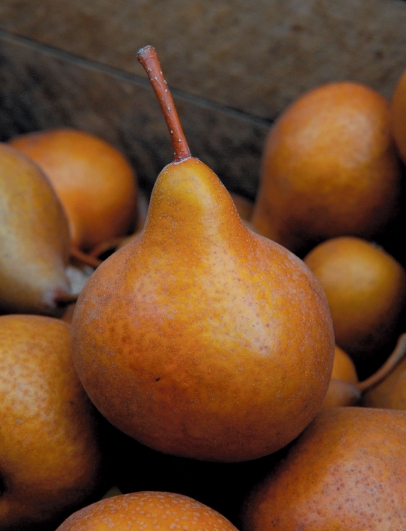Ripening Pears Deliver the Flavor of Fall
WHAT’S IN SEASON
The ripening of pears on local trees, and their appearance at local markets, mark the tipping of summer into fall. Quince, pomegranates and persimmons follow closely behind.
There is such a wide array of this quintessentially fall fruit, in colors ranging from red to yellow, green, and russet, in various sizes and shapes, how is one to choose? Well, you can start with understanding that some pears are better for cooking than others, holding their shape under heat, while some are best for eating out of hand. Different varieties also have varying levels of sweetness.
The elegant, long-necked Bosc is my personal favorite. These pears have a firm flesh that is equally good for baking or slicing raw into salads, and they also work beautifully poached whole. I like to poach them in a combination of red wine, sugar and water, with a sprig or two of rosemary, turning them as they cook and become a deep garnet red. They also stand up well to sautéing in savory dishes such as seared duck with pears and apples. Boscs, as well as another common pear variety, the Anjou, work well baked into tarts and crumbles.
Other pear varieties include Bartlett and Comice. The Bartlett is usually sold green, and as it ripens it changes color to become a pale golden yellow. Red Bartletts won’t change color, but they will evolve to be even brighter and more vibrant when fully ripe. Bartletts and Comice are exceedingly juicy pears and make for sweet eating, but they don’t hold their shape well when cooked.
Other pears to consider are the small Seckel and the French butter pears. The Seckel is sometimes only large enough for two or three bites, making it a good lunch box pear. French butter pears, or poires beurre, are quite delicate and when fully ripe have flesh as smooth as butter, and are typically served at dessert.
In general, pears are a good choice for dessert, especially accompanied by cheese. In France, pears are often served whole, and the French have specific fruit cutlery, which consists of small forks and matching, very sharp, knives, which are traditionally placed with the fruit course. However, lacking these, fork and paring knives would be used.
Almost all of California’s pears are grown in Northern California in Mendocino and Lake Counties, as well as the Sacramento Delta region. The annual harvest starts in mid-July in the Sacramento Delta district, especially around Courtland. At the end of July, harvest begins in Mendocino County, centered in Potter Valley and Ukiah. A few weeks later harvest begins in Lake County around Kelseyville, and the harvests continue into fall, depending on varieties.
All pears are picked before they are ripe. If left to ripen on the trees, they’ll turn to mush. So it’s best to plan ahead from two to four days before you want to eat them to allow your pears to ripen. After purchase, place them in a paper bag on your kitchen counter. To test for ripeness, give the flesh around the pear’s stem end a gentle push. If it gives slightly, the pear is ripe and ready to eat.





